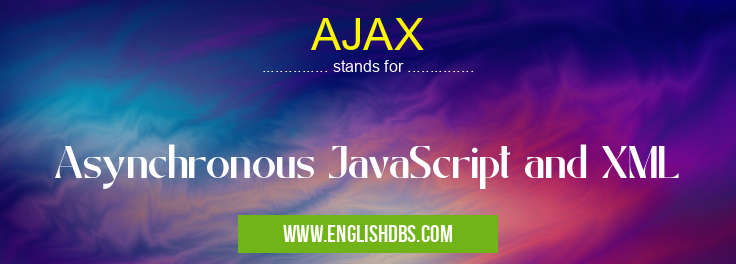What does AJAX mean in SOFTWARE
AJAX stands for Asynchronous JavaScript and XML. It is a group of related technologies that are used on the web to create interactive or dynamic websites. With AJAX, web developers can quickly transfer data between clients and servers or even different parts of a page without refreshing the page. This allows for faster response times from web pages and an overall better user experience when navigating around a website or application.

AJAX meaning in Software in Computing
AJAX mostly used in an acronym Software in Category Computing that means Asynchronous JavaScript and XML
Shorthand: AJAX,
Full Form: Asynchronous JavaScript and XML
For more information of "Asynchronous JavaScript and XML", see the section below.
How Does AJAX Work? AJAX works using three main components
HTML (Hypertext Markup Language) and CSS (Cascading Style Sheets) on the client side, and JavaScript on the server side. HTML is used to structure content while CSS is used for styling elements on a webpage. JavaScript is then used on both sides of the interaction—on the client side, it enables users to perform actions; while on the server side, it communicates with databases and other applications such as servers hosting images or documents related to the webpage being viewed by users.
When working with AJAX technology, developers design custom scripts using JavaScript that allow them to communicate with databases every time a user performs an action such as clicking on a list item or submitting form data. The script will then send an asynchronous request back either directly from their browser or through their server where it will be processed according to set parameters before responding in turn with requested data or features without having needlessly reloaded any part of the page previously being viewed by the user. This allows User Interface (UI) elements such as menus and forms autocomplete functions more smoothly.
Essential Questions and Answers on Asynchronous JavaScript and XML in "COMPUTING»SOFTWARE"
What is AJAX?
AJAX is a type of programming language and web development approach that allows for the creation of dynamic, interactive websites and applications without requiring page reloads. It stands for Asynchronous JavaScript and XML and is based on two technologies: HTML or XHTML, CSS, JavaScript, DOM (Document Object Model), XML (Extensible Markup Language), XSLT (Extensible Stylesheet Language Transformations) and the XMLHttpRequest object.
What are the advantages of using AJAX?
The chief benefit of using AJAX is the increased speed with which data can be exchanged between a website or application and its server without requiring a full page refresh. This speeds up overall performance by reducing the number of HTTP requests needed to deliver information in real-time, resulting in faster loading pages that provide users with a more engaging experience. Additionally, it also allows developers to create web applications with more complex functionality.
How does AJAX work?
With AJAX, a website’s client-side programming communicates with its web server asynchronously in order to send requests for content such as images or text without having to force a full page reload each time. When this happens data from the server is received back in an XML format which the client-side code then reads through JavaScript that interprets it into usable data elements to then be displayed on the user's screen.
Is AJAX secure?
Yes, like any form of coding or development technique there are certain security measures that need to be taken when utilizing AJAX. This includes ensuring proper authentication procedures as well as implementing safeguards against cross-site scripting attacks (XSS). Also important is making sure all data sent from the server is encoded properly upon reception so hackers can't take advantage of potential vulnerabilities.
What tools are used for implementing AJAX?
Different technologies can be used for developing applications using AJAX such as jQuery, AngularJS, ReactJS etc., but one of the most popular frameworks currently employed by developers today would have to be Nodejs due to its fast runtime environment combined with features such as built-in caching and streaming capabilities among other things.
Does accessibly pose any challenges when using AJAX?
Generally speaking, yes accessibility does pose some challenges when dealing with dynamic websites created with AJAX because they don't always adhere to standard coding techniques required for making something accessible across all platforms including those for disabled users such as screen readers etc. Implementing Accessible Rich Internet Applications (ARIA) per guidelines set forth by W3C can help overcome these issues though.
Final Words:
In conclusion, AJAX stands for Asynchronous JavaScript And XML and helps facilitate communication between different elements—such as clients-servers interactions—much quicker than before due its ability handle data requests separately from full page loads regardless how frequently these may happen within a short period of time. Many top tier websites rely heavily upon this technology because of its versatility and reliability in order provide their customers with quick access current information in ways never seen before until now!
